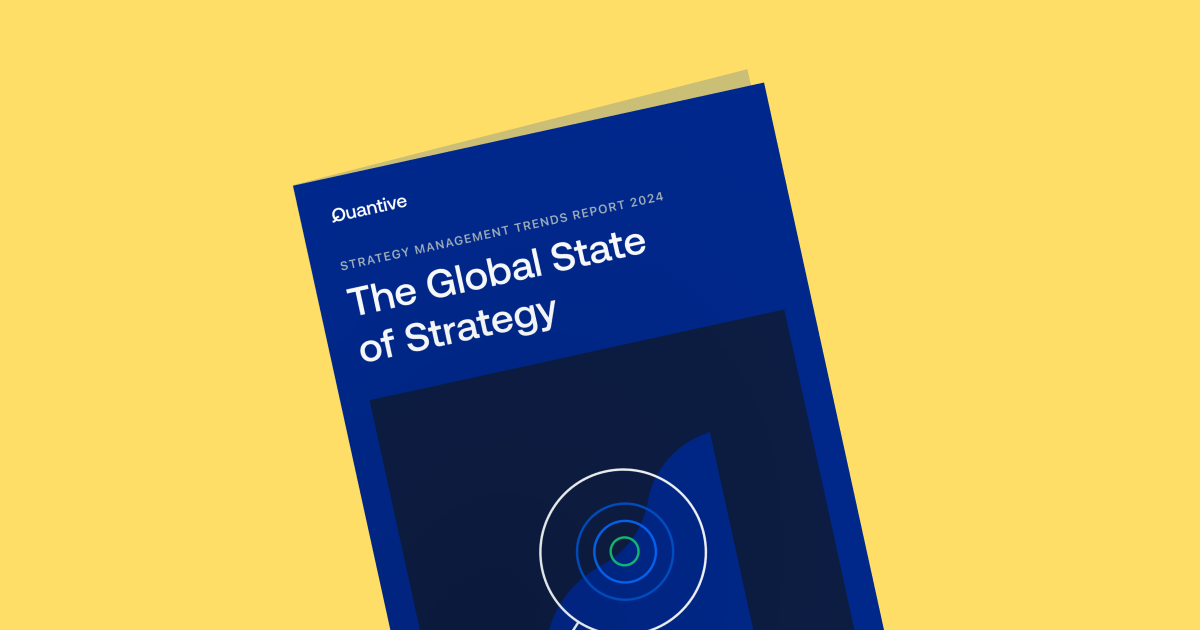Strategy development is the beating heart of effective business management. It’s about understanding your business’s current position, defining the path toward your business ambitions, and tailoring it to the business environment, using objectives and goals as milestones along the way. Without a robust strategy creation approach, your business risks navigating rocky market environments aimlessly, vulnerable to unexpected risks and missed opportunities.
Below, we cover quick-fire FAQs on strategy development, unpacking its definition, elements, and advantages to help you deliver the best results in today’s business landscape.
What is strategy development?
Strategy development involves assessing your business within its environment, considering both internal and external factors. It covers:
- Tailored business strategies aimed at value creation
- Comprehensive mitigation plans based on identified risks, scenarios, and trade-offs
- Clear communication and execution of plans using defined strategic goals and success metrics
What is the role of a strategic plan?
A strategic plan guides your business toward its long-term goals by focusing resources, actions, and priorities on a united purpose. It creates a shared understanding of the company’s direction among company leaders, stakeholders, and staff, ensuring they synchronize their efforts to serve a desired outcome.
Explore our step-by-step guide to strategic planning

What is the difference between strategy development and strategic planning?
Strategy development involves continuously analyzing, developing strategies, and refining business strategy based on the business's current state, risks, and emerging opportunities. Strategic planning is a subset of strategy development focused on creating resilient strategies for long-term business sustainability. Both processes are integral to the planning process, with company leaders playing a vital role in guiding and overseeing their execution.
What are some key reasons strategy development is important in business?
Strategy development is essential for several reasons. It:
- Establishes clear direction and purpose, helping employees understand the ‘why’ behind their work
- Identifies organizational strengths and weaknesses, aiding in effective resource allocation
- Allows your business to adapt to changing environments, repositioning it to suit shifting markets and circumstances
- Enhances decision-making, serving as a framework for evaluating performance and progress
- Promotes innovation, fostering a competitive advantage through continuous improvement based on feedback loops
- Facilitates organizational alignment, ensuring conflicting efforts are reduced as departments work cohesively toward shared goals
- Guides risk management, offering a structured approach to assessing and mitigating risks
How do you develop a strategic plan?
The development of a strategic plan involves several key steps:
- Analyze: Assess your business's current state to understand its strengths and opportunities while minimizing weaknesses and threats
- Develop strategy: Create a strategic plan that navigates your business toward its desired state, identifying strategic options for risks and outlining financial planning concerning resources, budgets, and trade-offs
- Align and communicate: Communicate your business's vision, mission, and long-term goals, aligning these using a goal-setting framework like OKRs
- Create action plans: Detail execution plans, establishing responsibilities and timelines for accountability
Implementing your strategic plan requires successful execution that emphasizes measurability. This serves as a continuous feedback loop that drives the strategy creation’s adaptation and optimization, ensuring your strategy doesn’t miss out on market opportunities.
Why should past strategic performance be part of strategy development?
Past strategic performance provides insights into what worked and what didn’t, enabling your business to refine future strategies, embrace practical approaches, and steer clear of prior errors. Historical data also nurtures organizational know-how, empowering your company to evolve and enhance strategy creation effectiveness as it gathers knowledge over time. Frameworks such as key performance indicators (KPIs) and OKRs can be valuable tools in evaluating past performance and informing future strategy, helping company leaders make informed decisions.
Which approach to strategy development is most likely to produce competitive advantage?
A strategy built on innovation and ongoing adaptation is a great way to gain a competitive advantage. Innovation is critical, driving differentiation to secure a competitive advantage. This involves introducing novel ideas, products, or processes that set your business apart from competitors.
Yet, an innovative spirit can fall short if it’s not aligned with the business environment. The crux lies with senior executives and their capacity to leverage critical, comprehensive, and timely data, as this dictates business agility and enables your business to tackle market shifts as they come.
What can hold back the realization of a strategic development plan?
Strategy development plans typically lack robust feedback loops, hindering continuous evaluation and adaptation. This absence results in stagnant plans unsuitable to dynamic markets, rendering them obsolete.
To maintain agile and relevant strategy development plans, you need real-time feedback — and technology-driven feedback loops powered by AI are an effective way to stay ahead. AI enables rapid data analysis, supporting adaptive decision-making in dynamic environments. As such, using it for strategic insights allows your business to adapt plans to market changes, analyze trends, and incorporate internal insights, ensuring ongoing relevance, resilience, and success in your strategy development approach.
How creative should strategy development be?
Creativity fuels strategy development. It empowers your business to innovate, explore new paths, and craft unique value propositions. However, creative strategic concepts must be substantiated to ensure alignment with market realities. Powering your creative ideas with data-backed insights can refine and validate these, providing empirical support for strategy creation. As such, a blend of creativity and data-driven strategies is essential to creating validated visionary strategies primed for success.
How does strategic alignment between departments contribute to successful strategy implementation?
Alignment between different departments or units within your business is essential for effective strategy execution. When various parts of the organization work cohesively towards common strategic objectives, you minimize conflicts, optimize resource allocation, and enhance overall efficiency, contributing to successful strategy implementation. Effective alignment requires active involvement and leadership from company leaders to ensure coherence across the organization.
What is the difference between a deliberate and an emergency strategy development process?
Deliberate strategy development is a pre-planned strategic approach aligned with long-term objectives. Think of it as a systematic process focused on structured planning and execution. In contrast, emergency strategy development is reactive, responding to unforeseen events or crises. It requires quick decision-making and implementation to navigate immediate challenges and mitigate their impact.
The best strategy development approach blends deliberate, long-term planning with the flexibility to pivot, optimize, and refine based on data-driven insights. At Quantive, we call this the Always-On Strategy model.
Powered by ongoing measurements and continuous optimizations, the Always-On Strategy operates as a dynamic loop, continuously developing, executing, and evaluating strategies. It prioritizes business agility and alignment with market shifts, emphasizing continual strategic readiness to avoid surprises and prevent strategies from becoming obsolete. By leveraging real-time insights, the Always-On Strategy model enables swift, informed decisions and ongoing refinements, ensuring your business strategy remains relevant and adaptable.
Discover the Always-On Strategy model

What is strategy deployment? How does it differ from strategy development?
Strategy deployment involves translating your formulated strategy into actionable steps and ensuring its effective implementation across all business levels. Strategy development is the process preceding strategy deployment and consists of the conceptualization, formulation, and planning of business strategies.
How often should strategy development occur?
While many companies stick to traditional annual strategy reviews, this approach is typically inflexible, rigid, and time-consuming. Instead, focus on creating a dynamic strategy by consistently revisiting and optimizing it to ensure continuous alignment with the evolving market and business landscape.
By setting an ongoing schedule for strategic optimizations using best practices such as pre-scheduled planning and regular reviews, you emphasize the significance of strategic agility for stakeholders. Moreover, this approach enables ongoing strategic reassessments while avoiding unnecessary or impulsive changes.
Should companies seek external support when developing their strategy?
While not always necessary, a fresh pair of impartial eyes can be immensely valuable to your strategy development process, offering expertise and experience that might not be available internally. This can include support with activities such as strategic analysis, market research, problem-solving, and industry-specific best practices — all of which can enrich your strategy development process.
Read more on the success of centralized vs. decentralized strategies

Similarly, the right technology can significantly enhance strategic development. AI-powered solutions not only enable you to analyze your market environment and sift through large amounts of existing data quickly, but also contribute to data-driven strategic decisions. This not only aligns your business with market threats and opportunities but also helps with eliminating biases and navigating organizational politics often associated with this process.
Who owns strategy development?
Strategy development isn't a one-person job. It's a collaborative effort that involves strategic management from key decision-makers who draw on insights from across the organization. This helps your business account for diverse perspectives and contributions to ensure your strategy development plan is well-rounded and comprehensive.
How is strategy development evolving?
Integrating technology and ESG in strategy development is becoming the norm.
The right tech tools can help your business navigate the onslaught of business uncertainties using the right data. AI, machine learning, and big data play a pivotal role in rapidly analyzing your business environment to drive quick, informed decision-making that seamlessly align your strategy with changing market needs. Additionally, the push for sustainability and social responsibility push for ESG-aligned strategic initiatives as part of strategic development.
Quantive empowers modern organizations to turn their ambitions into reality through strategic agility. It's where strategy, teams, and data come together to drive effective decision-making, streamline execution, and maximize performance.
As your company navigates today’s competitive landscape, you need an Always-On Strategy to continuously bridge the gap between current and desired business outcomes. Quantive brings together the technology, expertise, and passion to transform your strategy from a static plan to a feedback-driven engine for growth.
Whether you’re a visionary start-up, a mid-market business looking to conquer, or a large enterprise facing disruption, Quantive keeps you ahead — every step of the way. For more information, visit www.quantive.com.

